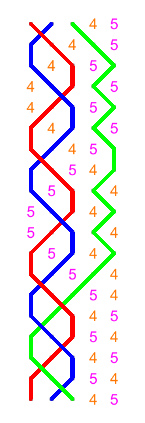Developing ropesight
Benefits of using a simulator
Exercises that develop ropesight by watching from outside the circle can often be more easily seen by watching the moving ringers on simulator software. Advantages include:
- Ability to ring in slow motion at the start – six-hour peal speed made faster as success develops until ringing at a normal but slowish speed.
- Perfect striking and no method mistakes!
- Opportunity to learn from watching methods which might be beyond the capability of the band to ring.
- No chance of an observer's comment upsetting a more experienced ringer!
Covering exercises
Try Cloister Doubles. There are just three bells to watch, but is has a six bell rhythm and speed. Explain about the dodges causing two bells to alternate for six blows. The learner gets three goes at spotting the two bells to follow alternately, before one goes and is replaced by another. You can change from a Plain Bob start to a Grandsire start to prevent students remembering numbers.
Covering Plain Bob Minimus increases the number of bells to watch to four. Initially the learner can watch the method being rung very slowly, looking for the last bell in each row. Speed up the ringing as calling out which bell is last becomes faster and more accurate, till it is being rung at a speed at which the learner will be able to control the bell. Finally add a cover bell, and demonstrate covering, getting the learner to call out the last bell of each row, as before. Then give them a go.
Covering to Doubles is best started on Stedman rather than Plain Hunt or Plain Bob because of the six blows that a pair of bells alternate in 4-5 before one goes to the front and another comes to replace it, working with the bell that stayed at the back. They only have to look at the other three bells to see which is last. As in Cloister Doubles, it is good to talk them through the six-end by saying "now" when a bell moves away from the back and then asking them to see who is ringing last "now" (stress it) to replace them. Both methods are a lot less frantic for the learner and it's easier to help them if they miss the bell at the back. You can point to the three bells on the screen they are looking at, or put your hands over the two they have just been following, leaving the three to be watched.
Following a bell
Following the treble (or any bell) through slow ringing in Plain Hunt Minimus. There is little point in just asking someone to follow, if no one is going to tell them what they are looking for, blow by blow. Ask them to watch the treble ring after one bell, then two bells then ring last (easier to see at this stage, than ring after three bells). You can slow it right down at first. If you have another ringer present, they could ring the treble, in which case, it will be greyed out, leaving the learner with just three ringers to watch on the screen.
In group sessions we watched Call Changes on four, whilst I asked questions such as "Which bell is ringing first?" "Which bell is last?" "Which bell is ring after number 2 bell?" Once this was successful, we started to watch Plain Bob Minimus rung at exceedingly slow speeds trying to see which bells rang in which place. I asked questions such as "Which bell is last at each handstroke. Just look at the sallies – don't watch the backstrokes?" "Now which bell is last at each backstroke. Don't look at the sallies – just watch the backstrokes as all hands and tailened are up in the air – whose comes down last". Sometimes I would pause after each row, and ask what order it had been ... then start and pause and ask again. To do this, I had to remember to hide the striking display and blue line or they could cheat!!!
Teaching methods

Cloister Doubles
» Ringing on higher numbers